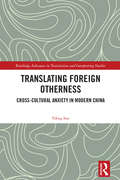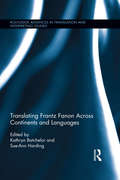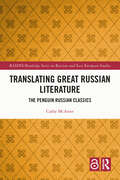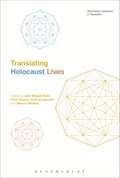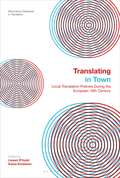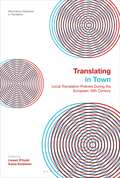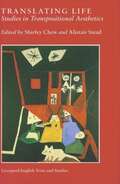- Table View
- List View
Translating for the European Union (Translation Practices Explained)
by Emma Wagner Svend Bech Jesús M. MartínezThe institutions of the European Union employ hundreds of translators. Why? What do they do? What sort of translation problems do they have to tackle? Has the language policy of the European Union been affected by the recent inclusion of new Member States? This book answers all those questions. Written by three experienced translators from the European Commission, it aims to help general readers, translation students and freelance translators to understand the European Union institutions and their work. Although it deals with written rather than spoken translation, much of the information it gives will be of interest to interpreters too. This second edition has been updated to reflect the new composition of the EU and changes to recruitment procedures.
Translating for the European Union Institutions (Translation Practices Explained)
by Emma Wagner Svend Bech Jesús M. MartínezThe institutions of the European Union employ hundreds of translators. Why? What do they do? What sort of translation problems do they have to tackle? Has the language policy of the European Union been affected by the recent inclusion of new Member States? This book answers all those questions. Written by three experienced translators from the European Commission, it aims to help general readers, translation students and freelance translators to understand the European Union institutions and their work. Although it deals with written rather than spoken translation, much of the information it gives will be of interest to interpreters too. This second edition has been updated to reflect the new composition of the EU and changes to recruitment procedures.
Translating for the European Union Institutions (Translation Practices Explained)
by Emma Wagner Svend Bech Jesús M. MartínezThe institutions of the European Union employ hundreds of translators. Why? What do they do? What sort of translation problems do they have to tackle? Has the language policy of the European Union been affected by the recent inclusion of new Member States? This book answers all those questions. Written by three experienced translators from the European Commission, it aims to help general readers, translation students and freelance translators to understand the European Union institutions and their work. Although it deals with written rather than spoken translation, much of the information it gives will be of interest to interpreters too. This second edition has been updated to reflect the new composition of the EU and changes to recruitment procedures.
Translating Foreign Otherness: Cross-Cultural Anxiety in Modern China (Routledge Advances in Translation and Interpreting Studies)
by Yifeng SunThis book explores the deep-rooted anxiety about foreign otherness manifest through translation in modern China in its endeavours to engage in cross-cultural exchanges. It offers to theorize and contextualize a related range of issues concerning translation practice in response to foreign otherness. The book also introduces new vistas to some of the under-explored aspects of translation practice concerning ideology and cultural politics from the late Qing dynasty to the present day. Largely as a result of translation, ethnocentric beliefs and feelings have given way to a more open and liberal way to approach and appropriate foreign otherness. However, the fear of Westernization, seen as a threat to Chinese cultural integrity and social stability, is still shown sporadically through the state’s ideological control over translation. The book interprets, questions and reformulates a number of the key theoretical issues in Translation Studies and also demonstrates their ramifications in a bid to shed light on Chinese translation practice.
Translating Foreign Otherness: Cross-Cultural Anxiety in Modern China (Routledge Advances in Translation and Interpreting Studies)
by Yifeng SunThis book explores the deep-rooted anxiety about foreign otherness manifest through translation in modern China in its endeavours to engage in cross-cultural exchanges. It offers to theorize and contextualize a related range of issues concerning translation practice in response to foreign otherness. The book also introduces new vistas to some of the under-explored aspects of translation practice concerning ideology and cultural politics from the late Qing dynasty to the present day. Largely as a result of translation, ethnocentric beliefs and feelings have given way to a more open and liberal way to approach and appropriate foreign otherness. However, the fear of Westernization, seen as a threat to Chinese cultural integrity and social stability, is still shown sporadically through the state’s ideological control over translation. The book interprets, questions and reformulates a number of the key theoretical issues in Translation Studies and also demonstrates their ramifications in a bid to shed light on Chinese translation practice.
Translating Frantz Fanon Across Continents and Languages: Frantz Fanon Across Continents and Languages (Routledge Advances in Translation and Interpreting Studies)
by Kathryn Batchelor Sue-Ann HardingThis book provides an innovative look at the reception of Frantz Fanon’s texts, investigating how, when, where and why these—especially his seminal Les Damnés de la Terre (1961) —were first translated and read. Building on renewed interest in the author’s works in both postcolonial studies and revolutionary movements in recent years, as well as travelling theory, micro-history and histoire croisée interests in Translation Studies, the volume tells the stories of translations of Fanon’s texts into twelve different languages – Arabic, Danish, English, German, Italian, Norwegian, Persian, Polish, Russian, Serbo-Croatian, Swahili and Swedish – bringing both a historical and multilingual perspective to the ways in which Fanon is cited today. With contributions from an international, interdisciplinary group of scholars, the stories told combine themes of movement and place, personal networks and agency, politics and activism, archival research and textual analysis, creating a book that is a fresh and comprehensive volume on the translated works of Frantz Fanon and essential reading for scholars in translation studies, postcolonial studies, cultural studies, critical race studies, and African and African diaspora literature.
Translating Frantz Fanon Across Continents and Languages: Frantz Fanon Across Continents and Languages (Routledge Advances in Translation and Interpreting Studies)
by Kathryn Batchelor Sue-Ann HardingThis book provides an innovative look at the reception of Frantz Fanon’s texts, investigating how, when, where and why these—especially his seminal Les Damnés de la Terre (1961) —were first translated and read. Building on renewed interest in the author’s works in both postcolonial studies and revolutionary movements in recent years, as well as travelling theory, micro-history and histoire croisée interests in Translation Studies, the volume tells the stories of translations of Fanon’s texts into twelve different languages – Arabic, Danish, English, German, Italian, Norwegian, Persian, Polish, Russian, Serbo-Croatian, Swahili and Swedish – bringing both a historical and multilingual perspective to the ways in which Fanon is cited today. With contributions from an international, interdisciplinary group of scholars, the stories told combine themes of movement and place, personal networks and agency, politics and activism, archival research and textual analysis, creating a book that is a fresh and comprehensive volume on the translated works of Frantz Fanon and essential reading for scholars in translation studies, postcolonial studies, cultural studies, critical race studies, and African and African diaspora literature.
Translating Great Russian Literature: The Penguin Russian Classics (ISSN)
by Cathy McAteerLaunched in 1950, Penguin’s Russian Classics quickly progressed to include translations of many great works of Russian literature and the series came to be regarded by readers, both academic and general, as the de facto provider of classic Russian literature in English translation, the legacy of which reputation resonates right up to the present day. Through an analysis of the individuals involved, their agendas, and their socio-cultural context, this book, based on extensive original research, examines how Penguin’s decisions and practices when translating and publishing the series played a significant role in deciding how Russian literature would be produced and marketed in English translation. As such the book represents a major contribution to Translation Studies, to the study of Russian literature, to book history and to the history of publishing.
Translating Great Russian Literature: The Penguin Russian Classics (ISSN)
by Cathy McAteerLaunched in 1950, Penguin’s Russian Classics quickly progressed to include translations of many great works of Russian literature and the series came to be regarded by readers, both academic and general, as the de facto provider of classic Russian literature in English translation, the legacy of which reputation resonates right up to the present day. Through an analysis of the individuals involved, their agendas, and their socio-cultural context, this book, based on extensive original research, examines how Penguin’s decisions and practices when translating and publishing the series played a significant role in deciding how Russian literature would be produced and marketed in English translation. As such the book represents a major contribution to Translation Studies, to the study of Russian literature, to book history and to the history of publishing.
Translating Holocaust Lives (Bloomsbury Advances in Translation)
by Jean Boase-Beier Peter Davies Andrea Hammel Marion WintersFor readers in the English-speaking world, almost all Holocaust writing is translated writing. Translation is indispensable for our understanding of the Holocaust because there is a need to tell others what happened in a way that makes events and experiences accessible – if not, perhaps, comprehensible – to other communities.Yet what this means is only beginning to be explored by Translation Studies scholars. This book aims to bring together the insights of Translation Studies and Holocaust Studies in order to show what a critical understanding of translation in practice and context can contribute to our knowledge of the legacy of the Holocaust. The role translation plays is not just as a facilitator of a semi-transparent transfer of information. Holocaust writing involves questions about language, truth and ethics, and a theoretically informed understanding of translation adds to these questions by drawing attention to processes of mediation and reception in cultural and historical context. It is important to examine how writing by Holocaust victims, which is closely tied to a specific language and reflects on the relationship between language, experience and thought, can (or cannot) be translated. This volume brings the disciplines of Holocaust and Translation Studies into an encounter with each other in order to explore the effects of translation on Holocaust writing. The individual pieces by Holocaust scholars explore general, theoretical questions and individual case studies, and are accompanied by commentaries by translation scholars.
Translating Holocaust Lives (Bloomsbury Advances in Translation)
by Jean Boase-Beier Peter Davies Andrea Hammel Marion WintersFor readers in the English-speaking world, almost all Holocaust writing is translated writing. Translation is indispensable for our understanding of the Holocaust because there is a need to tell others what happened in a way that makes events and experiences accessible – if not, perhaps, comprehensible – to other communities.Yet what this means is only beginning to be explored by Translation Studies scholars. This book aims to bring together the insights of Translation Studies and Holocaust Studies in order to show what a critical understanding of translation in practice and context can contribute to our knowledge of the legacy of the Holocaust. The role translation plays is not just as a facilitator of a semi-transparent transfer of information. Holocaust writing involves questions about language, truth and ethics, and a theoretically informed understanding of translation adds to these questions by drawing attention to processes of mediation and reception in cultural and historical context. It is important to examine how writing by Holocaust victims, which is closely tied to a specific language and reflects on the relationship between language, experience and thought, can (or cannot) be translated. This volume brings the disciplines of Holocaust and Translation Studies into an encounter with each other in order to explore the effects of translation on Holocaust writing. The individual pieces by Holocaust scholars explore general, theoretical questions and individual case studies, and are accompanied by commentaries by translation scholars.
Translating Home in the Global South: Migration, Belonging, and Language Justice (ISSN)
by Isabel C. Gómez Marlene Hansen EsplinThis collection explores the relationships between acts of translation and the movement of peoples across linguistic, cultural, and physical borders, centering the voices of migrant writers and translators in literatures and language cultures of the Global South.To offer a counterpoint to existing scholarship, this book examines translation practices as forms of both home-building and un-homing for communities in migration. Drawing on scholarship from translation studies as well as eco-criticism, decolonial thought, and gender studies, the book’s three parts critically reflect on different dimensions of the intersection of translation and migration in a diverse range of literary genres and media. Part I looks at self-translation, collaboration, and cocreation as modes of expression born out of displacement and exile. Part II considers radical strategies of literary translation and the threats and opportunities they bring in situations of detention and border policing. Part III looks ahead to the ways in which translation can act as a powerful means of fostering responsibility, solidarity, and community in building an inclusive, multilingual public sphere even in the face of climate crisis.This dynamic volume will be of particular interest to students and scholars in translation studies, migration and mobility studies, postcolonial studies, and comparative literature.
Translating Home in the Global South: Migration, Belonging, and Language Justice (ISSN)
by Isabel C. Gómez Marlene Hansen EsplinThis collection explores the relationships between acts of translation and the movement of peoples across linguistic, cultural, and physical borders, centering the voices of migrant writers and translators in literatures and language cultures of the Global South.To offer a counterpoint to existing scholarship, this book examines translation practices as forms of both home-building and un-homing for communities in migration. Drawing on scholarship from translation studies as well as eco-criticism, decolonial thought, and gender studies, the book’s three parts critically reflect on different dimensions of the intersection of translation and migration in a diverse range of literary genres and media. Part I looks at self-translation, collaboration, and cocreation as modes of expression born out of displacement and exile. Part II considers radical strategies of literary translation and the threats and opportunities they bring in situations of detention and border policing. Part III looks ahead to the ways in which translation can act as a powerful means of fostering responsibility, solidarity, and community in building an inclusive, multilingual public sphere even in the face of climate crisis.This dynamic volume will be of particular interest to students and scholars in translation studies, migration and mobility studies, postcolonial studies, and comparative literature.
Translating in the Local Community (Routledge Advances in Translation and Interpreting Studies)
by Peter FlynnThis volume showcases different forms of natural and nonprofessional translation and interpreting at work at multilingual sites in a single city, shedding new light on our understanding of the intersection of city, migration, and translation. Flynn builds on work in sociolinguistics, linguistic ethnography, and anthropology to offer a translational perspective on scholarship on multilingualism and translation, focusing on examples from the superdiverse city of Ghent in Belgium. Each chapter comprises a different multilingual site, ranging from schools to eateries to street corners, and unpacks specific dimensions of translation practices within and against constantly shifting multilingual settings. The book also reflects on sociopolitical factors and methodological considerations of concern when undertaking such an approach. Taken together, the volume seeks to provide a composite picture of translation in a multilingual city, demonstrating how tracing physical, linguistics, and social trajectories of movement in these contexts can deepen our understanding of the contemporary dynamics of nonprofessional translation, multilingualism, and translanguaging more broadly. This book will be of interest to students and scholars in translation and interpreting studies, sociolinguistics, multilingualism, linguistic anthropology, and migration studies.
Translating in the Local Community (Routledge Advances in Translation and Interpreting Studies)
by Peter FlynnThis volume showcases different forms of natural and nonprofessional translation and interpreting at work at multilingual sites in a single city, shedding new light on our understanding of the intersection of city, migration, and translation. Flynn builds on work in sociolinguistics, linguistic ethnography, and anthropology to offer a translational perspective on scholarship on multilingualism and translation, focusing on examples from the superdiverse city of Ghent in Belgium. Each chapter comprises a different multilingual site, ranging from schools to eateries to street corners, and unpacks specific dimensions of translation practices within and against constantly shifting multilingual settings. The book also reflects on sociopolitical factors and methodological considerations of concern when undertaking such an approach. Taken together, the volume seeks to provide a composite picture of translation in a multilingual city, demonstrating how tracing physical, linguistics, and social trajectories of movement in these contexts can deepen our understanding of the contemporary dynamics of nonprofessional translation, multilingualism, and translanguaging more broadly. This book will be of interest to students and scholars in translation and interpreting studies, sociolinguistics, multilingualism, linguistic anthropology, and migration studies.
Translating in Town: Local Translation Policies During the European 19th Century (Bloomsbury Advances in Translation)
by LievenKaisa D’hulst KoskinenTranslating in Town uncovers administrative and cultural multilingualism and translation practices in multilingual European communities during the long 19th century. Challenging the traditional narrative of nationalist, monolingual language ideologies, this book focuses instead upon translation policies which aimed to accommodate complex language situations with new democratic principles at local levels. Covering a time-frame from 1785 to 1914, chapters investigate towns and cities in the heartland of Europe, such as Barcelona, Milan and Vienna, as well as those on its outer rim, including Nicosia, Cork and Tampere. Highlighting the conflicts and negotiations that took place between official language(s), local language(s) and translation, the book explores the impact on both represented and non-represented monolingual and multilingual citizens. In so doing, Translating in Town highlights the subtle compromises obtained between official monolingualism, multilingualism and translation, and between competing views on official and private translation and transfer techniques, during this fascinating era of European history.
Translating in Town: Local Translation Policies During the European 19th Century (Bloomsbury Advances in Translation)
Translating in Town uncovers administrative and cultural multilingualism and translation practices in multilingual European communities during the long 19th century. Challenging the traditional narrative of nationalist, monolingual language ideologies, this book focuses instead upon translation policies which aimed to accommodate complex language situations with new democratic principles at local levels. Covering a time-frame from 1785 to 1914, chapters investigate towns and cities in the heartland of Europe, such as Barcelona, Milan and Vienna, as well as those on its outer rim, including Nicosia, Cork and Tampere. Highlighting the conflicts and negotiations that took place between official language(s), local language(s) and translation, the book explores the impact on both represented and non-represented monolingual and multilingual citizens. In so doing, Translating in Town highlights the subtle compromises obtained between official monolingualism, multilingualism and translation, and between competing views on official and private translation and transfer techniques, during this fascinating era of European history.
Translating India
by Rita KothariThe cultural universe of urban, English-speaking middle class in India shows signs of growing inclusiveness as far as English is concerned. This phenomenon manifests itself in increasing forms of bilingualism (combination of English and one Indian language) in everyday forms of speech - advertisement jingles, bilingual movies, signboards, and of course conversations. It is also evident in the startling prominence of Indian Writing in English and somewhat less visibly, but steadily rising, activity of English translation from Indian languages. Since the eighties this has led to a frenetic activity around English translation in India's academic and literary circles. Kothari makes this very current phenomenon her chief concern in Translating India. The study covers aspects such as the production, reception and marketability of English translation. Through an unusually multi-disciplinary approach, this study situates English translation in India amidst local and global debates on translation, representation and authenticity. The case of Gujarati - a case study of a relatively marginalized language - is a unique addition that demonstrates the micro-issues involved in translation and the politics of language. Rita Kothari teaches English at St. Xavier's College, Ahmedabad (Gujarat), where she runs a translation research centre on behalf of Katha. She has published widely on literary sociology, postcolonialism and translation issues. Kothari is one of the leading translators from Gujarat. Her first book (a collaboration with Suguna Ramanathan) was on English translation of Gujarati poetry (Modern Gujarati Poetry: A Selection, Sahitya Akademi, New Delhi, 1998). Her English translation of the path-breaking Gujarati Dalit novel Angaliyat is in press (The Stepchild, Oxford University Press). She is currently working on an English translation of Gujarati short stories by women of Gujarat, a study of the nineteenth-century narratives of Gujarat, and is also engaged in a project on the Sindhi identity in India.
Translating India
by Rita KothariThe cultural universe of urban, English-speaking middle class in India shows signs of growing inclusiveness as far as English is concerned. This phenomenon manifests itself in increasing forms of bilingualism (combination of English and one Indian language) in everyday forms of speech - advertisement jingles, bilingual movies, signboards, and of course conversations. It is also evident in the startling prominence of Indian Writing in English and somewhat less visibly, but steadily rising, activity of English translation from Indian languages. Since the eighties this has led to a frenetic activity around English translation in India's academic and literary circles. Kothari makes this very current phenomenon her chief concern in Translating India. The study covers aspects such as the production, reception and marketability of English translation. Through an unusually multi-disciplinary approach, this study situates English translation in India amidst local and global debates on translation, representation and authenticity. The case of Gujarati - a case study of a relatively marginalized language - is a unique addition that demonstrates the micro-issues involved in translation and the politics of language. Rita Kothari teaches English at St. Xavier's College, Ahmedabad (Gujarat), where she runs a translation research centre on behalf of Katha. She has published widely on literary sociology, postcolonialism and translation issues. Kothari is one of the leading translators from Gujarat. Her first book (a collaboration with Suguna Ramanathan) was on English translation of Gujarati poetry (Modern Gujarati Poetry: A Selection, Sahitya Akademi, New Delhi, 1998). Her English translation of the path-breaking Gujarati Dalit novel Angaliyat is in press (The Stepchild, Oxford University Press). She is currently working on an English translation of Gujarati short stories by women of Gujarat, a study of the nineteenth-century narratives of Gujarat, and is also engaged in a project on the Sindhi identity in India.
Translating Institutions: An Ethnographic Study of EU Translation
by Kaisa KoskinenTranslating Institutions outlines a framework for research on translation in institutional settings, using the Finnish translation unit at the European Commission as a case study. Because of their foundational multilingualism, the institutions of the European Union could be described as both translating and translated institutions. The European Commission alone employs nearly two thousand translators, and it is translators who draft the vast majority of outgoing EU messages. Translating Institutions sets out to explore the organizational role and professional identity of this group of cultural mediators, a group that has remained relatively invisible despite its size and central institutional role, and to use the analysis of this data to elaborate broader methodological and theoretical issues. Translating Institutions adopts an ethnographic approach to explore the life and work of the translators at the centre of this study. In practice, this entails employing a number of different methods and interrogating various types of data. The three-level research design used covers the study of the institutional framework, the study of translators working in specific institutional settings, and the study of translated documents and their source texts. This is therefore a study of both texts and people in their institutional habitat. Given the methodological focus of the volume, the different methods and data are outlined in independent chapters: the institutional framework of translation (institutional ethnography), the physical location of the unit (observation), translators' own views of their role (focus group discussions), and a sociologically-oriented text analysis of a sample document (shifts analysis). Translating Institutions constitutes a valuable contribution to the sociology of translation. It opens up new avenues for research and offers a detailed framework for the study of institutional translation.
Translating Institutions: An Ethnographic Study of EU Translation
by Kaisa KoskinenTranslating Institutions outlines a framework for research on translation in institutional settings, using the Finnish translation unit at the European Commission as a case study. Because of their foundational multilingualism, the institutions of the European Union could be described as both translating and translated institutions. The European Commission alone employs nearly two thousand translators, and it is translators who draft the vast majority of outgoing EU messages. Translating Institutions sets out to explore the organizational role and professional identity of this group of cultural mediators, a group that has remained relatively invisible despite its size and central institutional role, and to use the analysis of this data to elaborate broader methodological and theoretical issues. Translating Institutions adopts an ethnographic approach to explore the life and work of the translators at the centre of this study. In practice, this entails employing a number of different methods and interrogating various types of data. The three-level research design used covers the study of the institutional framework, the study of translators working in specific institutional settings, and the study of translated documents and their source texts. This is therefore a study of both texts and people in their institutional habitat. Given the methodological focus of the volume, the different methods and data are outlined in independent chapters: the institutional framework of translation (institutional ethnography), the physical location of the unit (observation), translators' own views of their role (focus group discussions), and a sociologically-oriented text analysis of a sample document (shifts analysis). Translating Institutions constitutes a valuable contribution to the sociology of translation. It opens up new avenues for research and offers a detailed framework for the study of institutional translation.
Translating Italy for the Eighteenth Century: British Women, Translation and Travel Writing (1739-1797)
by Mirella AgorniTranslating Italy in the Eighteenth Century offers a historical analysis of the role played by translation in that complex redefinition of women's writing that was taking place in Britain in the second half of the eighteenth century. It investigates the ways in which women writers managed to appropriate images of Italy and adapt them to their own purposes in a period which covers the 'moral turn' in women's writing in the 1740s and foreshadows the Romantic interest in Italy at the end of the century. A brief survey of translations produced by women in the period 1730-1799 provides an overview of the genres favoured by women translators, such as the moral novel, sentimental play and a type of conduct literature of a distinctively 'proto-feminist' character. Elizabeth Carter's translation of Francesco Algarotti's II Newtonianesimo per le Dame (1739) is one of the best examples of the latter kind of texts. A close reading of the English translation indicates a 'proto-feminist' exploitation of the myth of Italian women's cultural prestige. Another genre increasingly accessible to women, namely travel writing, confirms this female interest in Italy. Female travellers who visited Italy in the second half of the century, such as Hester Piozzi, observed the state of women's education through the lenses provided by Carter. Piozzi's image of Italy, a paradoxical mixture of imagination and realistic observation, became a powerful symbolic source, which enabled the fictional image of a modern, relatively egalitarian British society to take shape.
Translating Italy for the Eighteenth Century: British Women, Translation and Travel Writing (1739-1797)
by Mirella AgorniTranslating Italy in the Eighteenth Century offers a historical analysis of the role played by translation in that complex redefinition of women's writing that was taking place in Britain in the second half of the eighteenth century. It investigates the ways in which women writers managed to appropriate images of Italy and adapt them to their own purposes in a period which covers the 'moral turn' in women's writing in the 1740s and foreshadows the Romantic interest in Italy at the end of the century. A brief survey of translations produced by women in the period 1730-1799 provides an overview of the genres favoured by women translators, such as the moral novel, sentimental play and a type of conduct literature of a distinctively 'proto-feminist' character. Elizabeth Carter's translation of Francesco Algarotti's II Newtonianesimo per le Dame (1739) is one of the best examples of the latter kind of texts. A close reading of the English translation indicates a 'proto-feminist' exploitation of the myth of Italian women's cultural prestige. Another genre increasingly accessible to women, namely travel writing, confirms this female interest in Italy. Female travellers who visited Italy in the second half of the century, such as Hester Piozzi, observed the state of women's education through the lenses provided by Carter. Piozzi's image of Italy, a paradoxical mixture of imagination and realistic observation, became a powerful symbolic source, which enabled the fictional image of a modern, relatively egalitarian British society to take shape.
Translating Life: Studies in Transpositional Aesthetics (Liverpool English Texts and Studies #33)
by Shirley Chew Alistair SteadThis volume brings together eighteen substantial essays by distinguished scholars, critics and translators, and two interviews with eminent figures of British theatre, to explore the idea and practice of translation. The individual, but conceptually related, contributions examine topics from the Renaissance to the present in the context of apt exploration of the translation process, invoking both restricted and extended senses of translation. The endeavour is to study in detail the theory, workings and implications of what might be called the art of creative transposition, effective at the level of interlingual transcoding, dynamic rewriting, theatrical and cinematic adaptation, intersemiotic or intermedial translation, and cultural exchange. Many of the essays focus on aspects of intertextuality, the dialogue with text, past and present, as they bear on the issue of translation, attending to the historical, political or cultural dimensions of the practice, whether it illuminates a gendered reading of a text or a staging of cultural difference. The historic and generic range of the discussions is wide, encompassing the Elizabethan epyllion, Sensibility fiction, Victorian poetry and prose, modern and postmodern novels, but the book is dominated by dramatic or performance-related applications, with major representation of fresh investigations into Shakespeare (from A Midsummer Night’s Dream to The Tempest) and foregrounding of acts of self-translation on stage, in the dramatic monologue and in fiction. Contributions from theatre practitioners such as Sir Peter Hall, John Barton and Peter Lichtenfels underscore the immense practical importance of the translator on the stage and the business of both acting and directing as a species of translation.
Translating Maternal Violence: The Discursive Construction of Maternal Filicide in 1970s Japan (Thinking Gender in Transnational Times)
by Alessandro CastelliniThis book provides the first full-length, English-language investigation of the multiple and often contradictory ways in which mothers who kill their children were portrayed in 1970s Japan. It offers a snapshot of a historical and social moment when motherhood was being renegotiated, and maternal violence was disrupting norms of acceptable maternal behaviour. Drawing on a wide range of original archival materials, it explores three discursive sites where the image of the murderous mother assumed a distinctive visibility: media coverage of cases of maternal filicide; the rhetoric of a newly emerging women’s liberation movement known as ūman ribu; and fictional works by the Japanese writer Takahashi Takako. Using translation as a theoretical tool to decentre the West as the origin of (feminist) theorizations of the maternal, it enables a transnational dialogue for imagining mothers' potential for violence. This thought-provoking work will appeal to scholars of feminist theory, cultural studies and Japanese studies.


